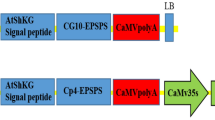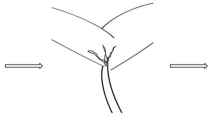Abstract
We investigated selective culturing conditions for the production of transgenic soybeans. In this culturing system, we used the acetolactate synthase (ALS)-inhibiting herbicide-resistance gene derived from rice (Os-mALS gene) as a selectable marker gene instead of that derived from bacteria, which interfered with the cultivation and practical usage of transgenic crops. T1 soybeans grown from one regenerated plant after selection of the ALS-targeting pyrimidinyl carboxy (PC) herbicide bispyribac-sodium (BS) exhibited herbicide resistance, and the introduction and expression of the Os-mALS gene were confirmed by genetic analysis. The selective culturing system promoted by BS herbicide, in which the Os-mALS gene was used as a selectable marker, was proved to be applicable to the production of transgenic soybeans, despite the appearance of escaped soybean plants that did not contain the Os-mALS transgene.






Similar content being viewed by others
References
Daley M, Knauf KR, Summerfert KR, Turner JC (1998) Co-transformation with one Agrobacterium tumefaciens strain containing two binary plasmids as a method for producing marker-free transgenic plants. Plant Cell Rep 17:489–496
Donaldson PA, Simmond DH (2000) Susceptibility to Agrobacterium tumefaciens and cotyledonary node transformation in short-season soybean. Plant Cell Rep 19:478–484
Ebinuma H, Sugita K, Matsunaga E, Endo S, Yamada K, Komamine A (2001) Systems for the removal of a selection marker and their combination with a positive marker. Plant Cell Rep 20:383–392
Endo S, Sugita K, Sakai M, Tanaka H, Ebinuma H (2002) Single-step transformation for generating marker-free transgenic rice using the ipt-type MAT vector system. Plant J 30:115–122
Furutani N, Hidaka S (2004) Efficient production of transgenic soybean using a co-transformation method. Breed Sci 54:91–98
Ganapathi TR, Higgs NS, Balint-Kurti PJ, Arntzen CJ, May GD, Van Eck JM (2001) Agrobacterium-mediated transformation of embryogenic cell suspensions of the banana cultivar Rasthali (AAB). Plant Cell Rep 20:157–162
Kawai K, Shimizu T, Kaku K, Izawa N, Tanaka Y (2003) Rice ALS gene as a selectable marker. Jpn Soc Plant Cell Mol Biol 21:78 (abstract in Japanese)
Kawai K, Kaku K, Izawa N, Shimizu T, Fukuda A, Tanaka Y (2007) A novel mutant acetolactate synthase gene from rice cells, which confers resistance to ALS-inhibiting herbicides. J Pestic Sci 32:89–98
Kawata M, Nakajima T, Yamamoto T, Mori K, Oikawa T, Fukumoto F, Kuroda S (2003a) Genetic engineering for disease resistance in rice (Oryza sativa L.) using antimicrobial peptides. JARQ 37:71–76
Kawata M, Yoshida H, Sonoda R, Hirayae K, Mori K, Uchida E, Kimizu M, Izawa N, Ohshima M, Ohtsuki H, Tanaka Y, Tanaka H, Kuroda S (2003b) Development of transgenic rice with disease resistance by making use of novel selectable marker gene and tissue specific promoters from rice. Breed Res 5(Suppl 2):334 (abstract in Japanese)
Matsumura Y, Ohshima M, Otake Y, Shimizu T, Kaku K, Nagayama K, Ban Y, Izawa N, Tanaka H, Kuroda S, Tanaka Y (2002) Modified ALS gene as a selectable marker for rice transformation. Breed Res 4(Suppl 2):197 (abstract in Japanese)
Mitsuhara I, Ugaki M, Hirochika H, Ohshima M, Murakami T, Gotoh Y, Katayose Y, Nakamura S, Honkura R, Nishimiya S, Ueno K, Mochizuki A, Tanimoto H, Tsugawa H, Otsuki Y, Ohashi Y (1996) Efficient promoter cassettes for enhanced expression of foreign genes in dicotyledonous and monocotyledonous plants. Plant Cell Physiol 37:49–59
Olhoft PM, Flagel LE, Donovan CM, Somers DA (2003) Efficient soybean transformation using hygromycin B selection in the cotyledonary-node method. Planta 216:723–735
Osakabe K, Endo M, Kawai K, Nishizawa Y, Ono K, Abe K, Ishikawa Y, Nakamura H, Ichikawa H, Nishimura S, Shimizu T, Toki S (2005) The mutant form of acetolactate synthase genomic DNA from rice is an efficient selectable marker for genetic transformation. Mol Breed 16:313–320
Paz MM, Martinez JC, Kalvig AB, Fonger TM, Wang K (2006) Improved cotyledonary node method using an alternative explant derived from mature seed for efficient Agrobacterium-mediated soybean transformation. Plant Cell Rep 25:206–213
Pornprom T, Usui K, Ishizuka K (2005) Growth inhibition and acetolactate synthase activity of soybean seedlings and suspension-cultured cells treated with bensulfuron-methyl. Weed Biol Manag 5:150–153
Ray K, Jagannath A, Gangwan SA, Burma PK, Pental D (2004) Mutant acetolactate synthase gene is an efficient in vitro selectable marker for the genetic transformation of Brassica juncea (oilseed mustard). J Plant Physiol 161:1079–1083
Sato H, Yamada T, Kita Y, Ishimoto M, Kitamura K (2007) Production of transgenic plants and their early seed set in Japanese soybean variety. Plant Biotechnol 24:533–536
Shimizu T, Nakayama I, Nagayama K, Miyazawa T, Nezu Y (2002) Acetolactate synthase inhibitors. In: Böger P, Wakabayashi K, Hirai K (eds) Herbicide classes in development: mode of action–Targets–Genetic Engineering–Chemistry. Springer, Berlin, pp 1–41
Tan S, Evans RR, Dahmer ML, Singh BK, Shaner DL (2005) Imidazolinone-tolerant crops: history, current status and future. Pest Manag Sci 61:246–257
Tougou M, Furutani N, Yamagishi N, Shizukawa Y, Takahata Y, Hidaka S (2006) Development of resistant transgenic soybeans with inverted repeat-coat protein genes of soybean dwarf virus. Plant Cell Rep 25:1213–1218
Tougou M, Yamagishi N, Furutani N, Shizukawa Y, Takahata Y, Hidaka S (2007) Soybean dwarf virus-resistant transgenic soybeans with the sense coat protein gene. Plant Cell Rep 26:1967–1975
Zeng P, Vadnais DV, Zhang Z, Polacco JC (2004) Refined glufosinate selection in Agrobacterium-mediated transformation of soybean [Glycine max (L.) Merrill]. Plant Cell Rep 22:478–482
Acknowledgments
We thank Motoko Kobayashi (NARCT) for technical assistance and Motoshige Kawata (National Institute of Crop Science, NICS) and Shuji Yokoi (Iwate University) for useful advice. This work was funded by the Project for the Development of Innovative Transgenic Plants of the Ministry of Agriculture, Forestry and Fisheries of Japan.
Author information
Authors and Affiliations
Corresponding author
Additional information
Communicated by J. R. Liu.
Rights and permissions
About this article
Cite this article
Tougou, M., Yamagishi, N., Furutani, N. et al. The application of the mutated acetolactate synthase gene from rice as the selectable marker gene in the production of transgenic soybeans. Plant Cell Rep 28, 769–776 (2009). https://doi.org/10.1007/s00299-009-0679-1
Received:
Revised:
Accepted:
Published:
Issue Date:
DOI: https://doi.org/10.1007/s00299-009-0679-1




